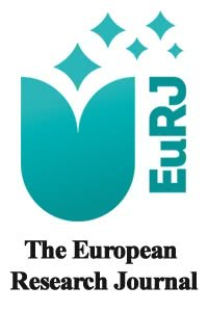Assessment of inflammatory parameters in obstructive coronary artery disease and cardiac syndrome X: an evolving value of neutrophil-lymphocyte ratio
Assessment of inflammatory parameters in obstructive coronary artery disease and cardiac syndrome X: an evolving value of neutrophil-lymphocyte ratio
___
- 1. Hoffman M, Blum A, Baruch R, Kaplan E, Benjamin M. Leukocytes and coronary heart disease. Atherosclerosis 2004;172:1-6.
- 2. Gillum RF, Mussolino ME, Madans JH. Counts of neutrophils, lymphocytes, and monocytes, cause-specific mortality and coronary heart disease: the NHANES-I epidemiologic follow-up study. Annals of epidemiology 2005;15:266-71.
- 3. Libby P. Vascular biology of atherosclerosis: overview and state of the art. Am J Cardiol 2003;91(3A):3A-6A.
- 4. Nunez J, Nunez E, Bodi V, Sanchis J, Minana G, Mainar L, et al. Usefulness of the neutrophil to lymphocyte ratio in predicting long-term mortality in ST segment elevation myocardial infarction. Am J Cardiol 2008;101:747-52.
- 5. Horne BD, Anderson JL, John JM, Weaver A, Bair TL, Jensen KR, et al. Which white blood cell subtypes predict increased cardiovascular risk? J Am Coll Cardiol 2005;45:1638-43.
- 6. Walsh SR, Cook EJ, Goulder F, Justin TA, Keeling NJ. Neutrophil-lymphocyte ratio as a prognostic factor in colorectal cancer. J Surg Oncol 2005;91:181-4.
- 7. Duffy BK, Gurm HS, Rajagopal V, Gupta R, Ellis SG, Bhatt DL. Usefulness of an elevated neutrophil to lymphocyte ratio in predicting long-term mortality after percutaneous coronary intervention. Am J Cardiol 2006;97:993-6.
- 8. Dentali F, Nigro O, Squizzato A, Gianni M, Zuretti F, Grandi AM, et al. Impact of neutrophils to lymphocytes ratio on major clinical outcomes in patients with acute coronary syndromes: A systematic review and meta-analysis of the literature. Int J Cardiol 2018;266:31-7.
- 9. Kaski JC, Rosano GM, Collins P, Nihoyannopoulos P, Maseri A, Poole-Wilson PA. Cardiac syndrome X: clinical characteristics and left ventricular function. Long-term follow-up study. J Am Coll Cardiol 1995;25:807-14.
- 10. Al Suwaidi J, Higano ST, Holmes DR Jr, Lerman A. Pathophysiology, diagnosis, and current management strategies for chest pain in patients with normal findings on angiography. Mayo Clin Proc 2001;76:813-22.
- 11. Bland JM, Altman DG. Statistical methods for assessing agreement between two methods of clinical measurement. Lancet 1986;1:307-10.
- 12. Libby P. Changing concepts of atherogenesis. J Intern Med 2000;247:349-58.
- 13. Deodhar SD. C-reactive protein: the best laboratory indicator available for monitoring disease activity. Cleve Clin J Med 1989;56:126-30.
- 14. Cook DG, Mendall MA, Whincup PH, Carey IM, Ballam L, Morris JE, et al. C-reactive protein concentration in children: relationship to adiposity and other cardiovascular risk factors. Atherosclerosis 2000;149:139-50.
- 15. Mendall MA, Patel P, Ballam L, Strachan D, Northfield TC. C reactive protein and its relation to cardiovascular risk factors: a population based cross sectional study. BMJ 1996;312:1061-5.
- 16. Sharma S, Ghalaut VS, Dixit R, Kumar S, George PJ. Microalbuminuria and C-reactive protein as a predictor of coronary artery disease in patients of acute chest pain. J Cardiovasc Dis Res 2013;4:37-9.
- 17. Lekakis JP, Papamichael CM, Vemmos CN, Voutsas AA, Stamatelopoulos SF, Moulopoulos SD. Peripheral vascular endothelial dysfunction in patients with angina pectoris and normal coronary arteriograms. J Am Coll Cardiol 1998;31:541- 6.
- 18. Tondi P, Santoliquido A, Di Giorgio A, Sestito A, Sgueglia GA, Flore R, et al. Endothelial dysfunction as assessed by flowmediated dilation in patients with cardiac syndrome X: role of inflammation. Eur Rev Med Pharmacol Sci 2011;15:1074-7.
- 19. Teragawa H, Fukuda Y, Matsuda K, Ueda K, Higashi Y, Oshima T, et al. Relation between C reactive protein concentrations and coronary microvascular endothelial function. Heart 2004;90:750-4.
- 20. Tousoulis D, Davies GJ, Asimakopoulos G, Homaei H, Zouridakis E, Ahmed N, et al. Vascular cell adhesion molecule1 and intercellular adhesion molecule-1 serum level in patients with chest pain and normal coronary arteries (syndrome X). Clin Cardiol 2001;24:301-4.
- 21. Kalay N, Dogdu O, Koc F, Yarlioglues M, Ardic I, Akpek M,et al. Hematologic parameters and angiographic progression of coronary atherosclerosis. Angiology 2012;63:213-7.
- 22. Tamhane UU, Aneja S, Montgomery D, Rogers EK, Eagle KA, Gurm HS. Association between admission neutrophil to lymphocyte ratio and outcomes in patients with acute coronary syndrome. Am J Cardiol 2008;102:653-7.
- 23. Azab B, Zaher M, Weiserbs KF, Torbey E, Lacossiere K, Gaddam S, et al. Usefulness of neutrophil to lymphocyte ratio in et al. Hematologic parameters and angiographic progression of coronary atherosclerosis. Angiology 2012;63:213-7.
- 22. Tamhane UU, Aneja S, Montgomery D, Rogers EK, Eagle KA, Gurm HS. Association between admission neutrophil to lymphocyte ratio and outcomes in patients with acute coronary syndrome. Am J Cardiol 2008;102:653-7.
- 23. Azab B, Zaher M, Weiserbs KF, Torbey E, Lacossiere K, Gaddam S, et al. Usefulness of neutrophil to lymphocyte ratio in
- ISSN: 2149-3189
- Yayın Aralığı: 6
- Başlangıç: 2015
- Yayıncı: Prusa Medikal Yayıncılık Limited Şirketi
Nephrotoxicity rates related to colistin and evaluation of risk factors
Ali Asan, Cuma Bülent Gül, İsra Karaduman, Nizameddin Koca, Canan Yılmaz, Şükran Köse, Gülsün Akınoğlu, Mustafa Özgür Akça, Derya Karasu
Sepideh DOLATİ, Khoosheh NAMİRANİAN, Zahra ABDOLLAHİ, Morteza ABDOLLAHİ
Semra Demirli ATICI, Semra SALİMOĞLU, Yasemin KIRMIZI, Dilek KUZUKIRAN, Cengiz AYDIN
Gamze Güney ESKİLER, Gülşah ÇEÇENER, Ünal EGELİ, Berrin TUNCA
Tezcan Peker, Dursun Topal, Bedrettin Boyraz, Alkeme Akgümüş, Mustafa YILMAZ, Ferit Onur Mutluer, Mehmet Demir, Erhan Tenekecioğlu
The prognostic role of Charlson comorbidity index for critically ill elderly patients
Abdulkerim Yıldız, Ali Ramazan Benli, Ali Yiğit
Betül Aydın BUYRUK, Goknur YORULMAZ, Ayşe Nur DEĞER, Medine Nur KEBAPÇI
Kemal KESEROGLU, Sibel ALICURA TOKGÖZ, Elif ÇELİK, İstemihan AKIN, Ali ÖZDEK
Yağmur ŞANCI, Lale Ayşegül BÜYÜKGÖNENÇ
Chondroid metaplasia: a rare subtype of metaplastic breast carcinoma
Cengiz Aydın, Yasemin Kırmızı, Semra Demirli Atıcı, Semra Salimoğlu, Dilek Kuzukıran
